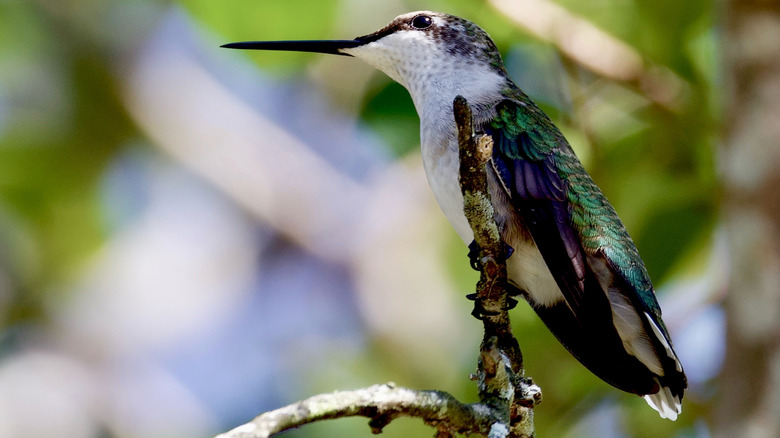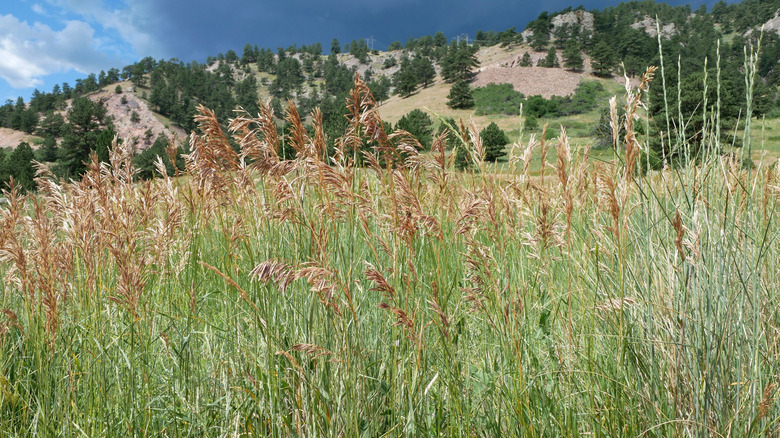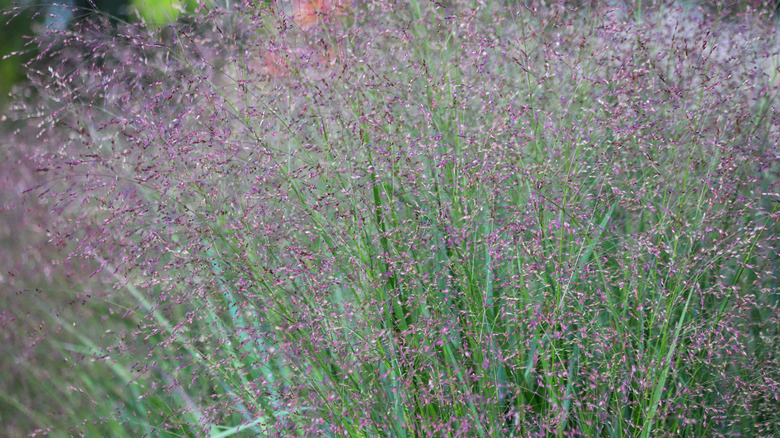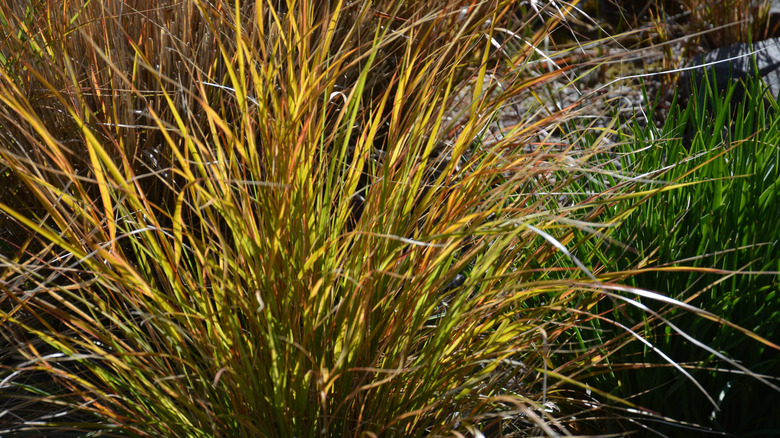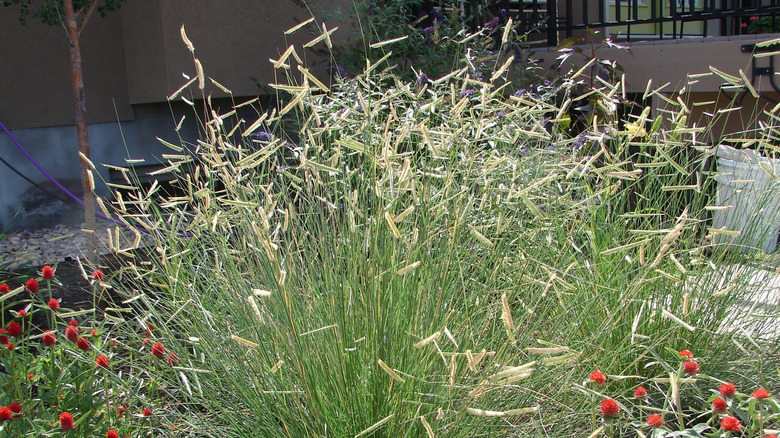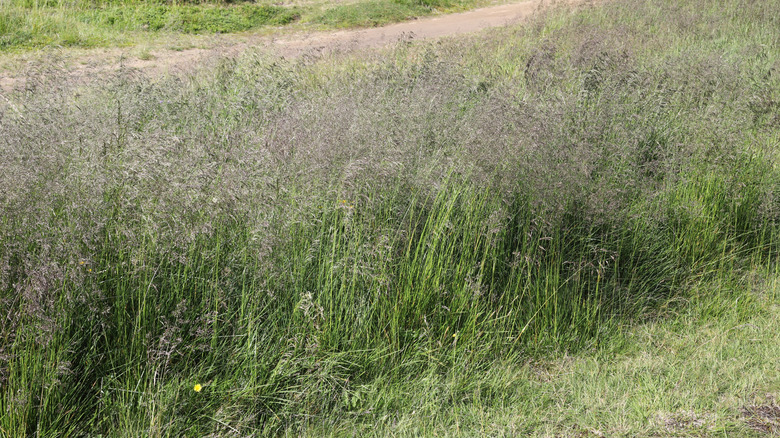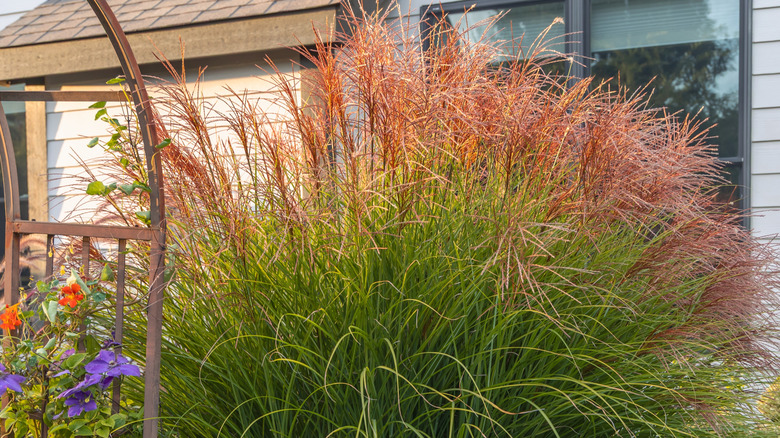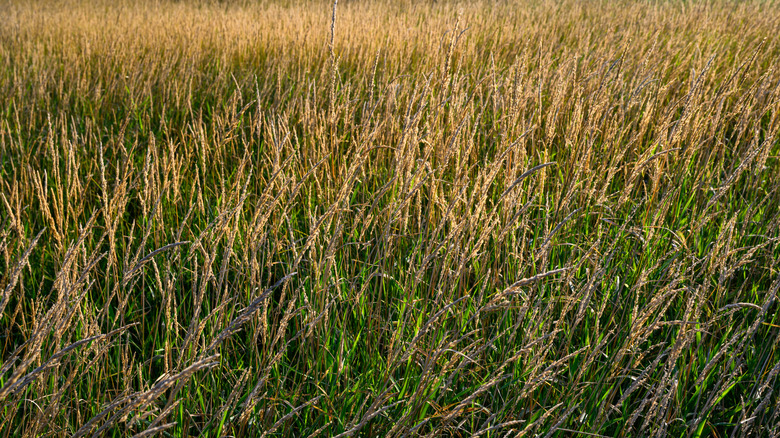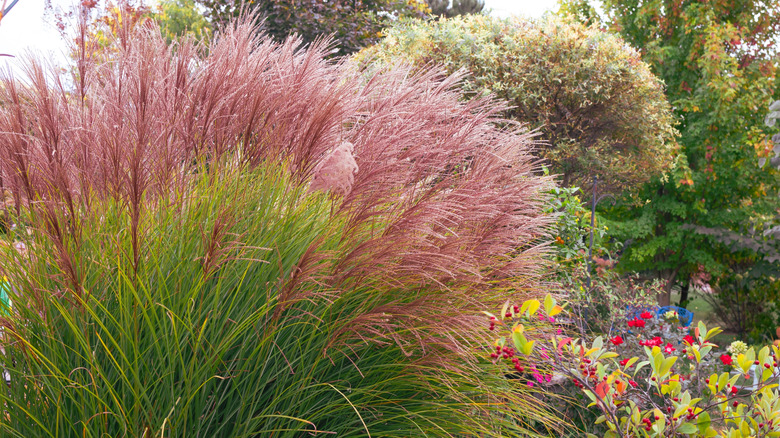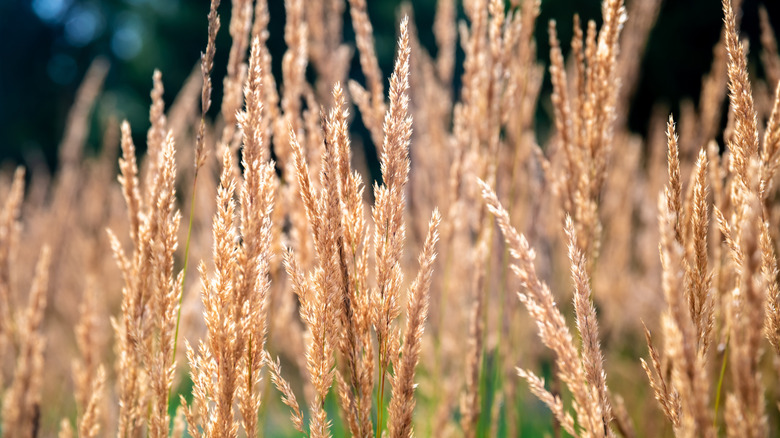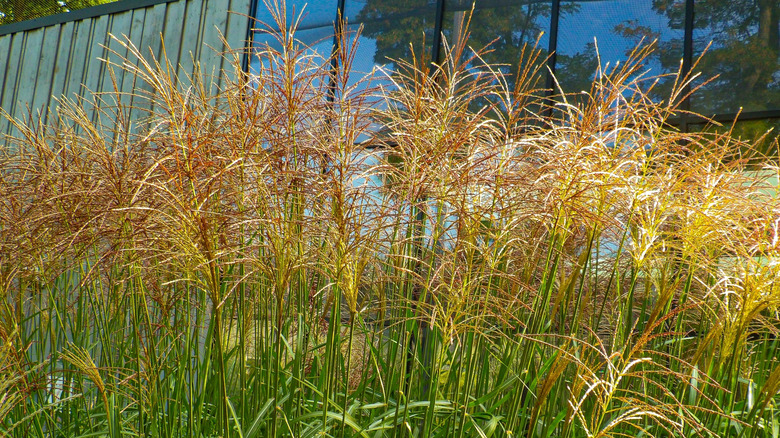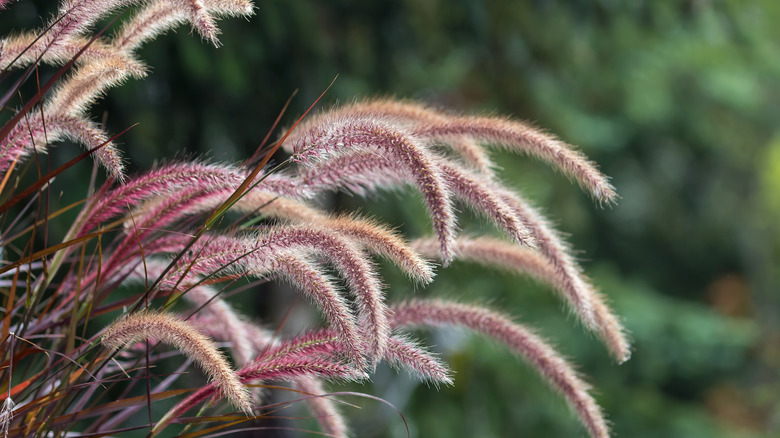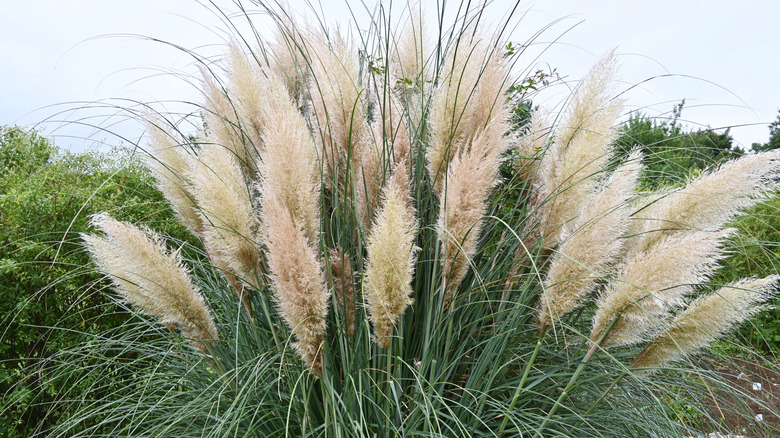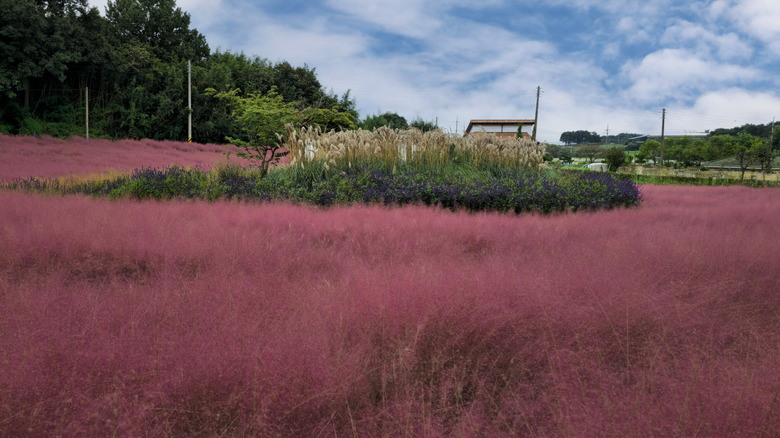13 Ornamental Grasses To Plant In The Fall For Hummingbirds To Enjoy Next Season
While flowers, produce, and herbs are the common ways to fill a garden, ornamental grasses shouldn't be overlooked. Most of the time, they pair well with other plants and create textural, color, and height differences for a bit of dimension. There are a lot of advantages to growing ornamental grasses in your yard and garden. One of the benefits you may not consider is that they can do their part to attract pollinators, including hummingbirds.
It's worth pointing out that most ornamental grasses don't provide flowers for hummingbirds to drink from. However, they can still serve a purpose. Many grasses provide them with nesting material that they can use to protect their eggs. Additionally, if your flowers are in an open area, these grasses give your hummingbirds a safe place to hide if a predator comes after them.
Hummingbirds, unlike other flying species, tend to rarely ever touch the ground. They are unable to walk and prefer to perch on branches or grass. So giving them places to escape is just as important as providing them with food. Tall grasses give them plenty of places to hide and observe an area before collecting nectar. Additionally, soft, silky, and fluffy grasses are often used to make nests. So if you are looking for an ornamental grass to plant in the fall that will look beautiful alongside your other plants and add some depth while also bringing in pollinators like hummingbirds, consider ones that fit those descriptors, such as the options below.
Big bluestem
Big bluestem (Andropogon gerardii) is a native species of the eastern and midwestern parts of the United States and thrives in USDA Hardiness Zones 4 to 9. It's a pretty tolerant plant that can handle all sorts of soil conditions. But, if you want it to stay tall and offer a great hiding place for hummingbirds, make sure you give it plenty of sun, or it may flop over. It can be planted in either fall or spring. If you plant it from seed, it can take up to three years to form a big clump.
'Shenandoah' switchgrass
'Shenandoah' switchgrass (Panicum virgatum 'Shenandoah') stands out because of its colors. It's a native prairie grass that produces dark red foliage and faintly pink flower spikes. It's hardy in Zones 4 through 9 and can grow up to 5 feet tall and 18 inches wide. Switchgrass grows quickly, and is usually ready to bloom once summer hits. This plant is tolerant, able to handle dry, moist, or even occasionally-flooded soils. Like big bluestem, it tends to flop over if it's not given enough sun, though, so try to focus on full sun areas.
New Zealand wind grass
New Zealand wind grass (Anemanthele lessoniana) is also commonly called pheasant's tail grass. It's a beautiful ornamental, sure to highlight a garden. In spring and summer, the foliage is green. However, in the fall, it tends to turn into a beautiful copper with greenish-purple flower heads. It is pretty narrow in its zone, as it is only hardy in Zones 8 to 10. It's not the tallest plant, so it may not be ideal for hummingbirds to hide, but it can work as a perching space, and its fluffy stalks can be great for nesting.
'Blonde Ambition' blue grama grass
Hardy in Zones 4 to 9, 'Blonde Ambition' blue grama grass (Bouteloua gracilis 'Blue Ambition') is an easy-to-care-for ornamental. It can get up to 3 feet tall and produces pretty greenish-yellow flowers in the summer that stand out against the bluish-gray grass. They are perfect for making hummingbird nests. Also, because this plant is so hardy, it's a great option to grow in areas of your garden where other flora may struggle to grow. This variety tends to be one of the larger options available, which makes it a little better for hiding hummingbirds.
Tufted hairgrass
Tufted hairgrass (Deschampsia cespitosa) can grow up to 3 feet tall. The height and growing conditions of this plant make it a stunning ornamental grass to grow beautifully alongside hydrangeas. It's ideal for Zones 4 to 9, and can be left at full height in the winter as it handles the snow quite well. One of the reasons this plant stands out from other ornamental grasses so well is that it actually doesn't mind living in partial shade. Its deer and rabbit resistance make it a durable plant to protect the rest of your garden.
'Morning Light' maiden grass
Maiden grass is an over-the-top ornamental grass perfect for your yard. There are a few varieties to choose from, but the 'Morning Light' maiden grass (Miscanthus sinensis 'Morning Light') is a great one that you can plant in early fall. This variety can grow up to 5 feet tall and is hardy in Zones 5 to 9. Though it isn't native to the U.S., it has naturalized in many states. It enjoys full sun, but it can also tolerate partial shade. Its height and feathery tips makes it an excellent choice for sheltering hummingbirds.
Ribbon grass
Ribbon grass, also known as reed canary grass (Phalaris arundinacea), is another great ornamental plant to consider planting in the fall. It's hardy from Zone 3 to 9, working in much of the United States. It's not the tallest option, only growing to 4 feet high, but it is a stunning plant to provide some shade and protection around beautiful perennials that hummingbirds love, like lilies. It also helps to provide ground cover and some protection in areas you might otherwise be left wide open. It also produces feathery stalks to be used for nesting materials.
'Gracillimus' maiden grass
'Gracillimus' maiden grass (Miscanthus sinensis 'Gracillimus') is another variation of maiden grass. This one can grow up to 8 feet tall and is excellent in Zones 4 through 9. It's a durable plant once it establishes its root system. Because of its stability and height, it can double as a protective barrier, blocking you from wind and prying eyes and providing shelter for animals of all shapes and sizes, including hummingbirds. The tufted tops catch the eye and make a brilliant but somewhat subtle addition to any garden.
'Karl Foerster' feather reed grass
'Karl Foerster' Feather Reed Grass (Calamagrostis acutiflora 'Karl Foerster') is a great place for hummingbirds to rest and hide. In fact, it's an ornamental grass that doubles as a stylish natural privacy screen for your yard as well, potentially growing up to 6 feet tall. It's hardy in Zones 5 to 11. It's not the most colorful ornamental grass out there, but it is a great option if you just want a little contrast. In addition to helping out hummingbirds, it is also deer-resistant and attracts other bird species.
Korean feather reed grass
Korean feather reed grass (Calamagrostis brachytricha) is another species of feather grass you can plant in the fall. This one is native to Asia but is able to tolerate most of the conditions in the United States. It is a little small, only getting about 4 feet tall, and it actually looks similar in appearance to 'Karl Foerster.' However, it's got more open feathery tufts and tends to grow a little wider. It also grows well in partial shade and prefers well-draining soil. Like most other ornamental grasses, it is hardy in Zones 4 to 9.
Purple fountain grass
Purple fountain grass (Pennisetum setaceum 'Rubrum') is a 3- to 4-foot plant that is purple in color and has big feathery tufts. It's a beautiful ornamental grass, and is hardy in Zones 8 to 11. If you are planting purple fountain grass from seed, you want to make sure you do it about seven weeks before your first average frost date. However, you can also transplant it a week or two before. In essence, you just want your ornamental grass to be able to form established roots ahead of the cold weather.
Pampas grass
While the best time to plant pampas (Cortaderia selloana) is in the spring, realistically, it can be started at any point in Zones 7 to 11. If you don't fight with an abundance of wet weather in the fall and winter, or you're willing to take steps to protect your grass during harsher weather events, then you can plant pampas in the fall as well. These plants have the potential to grow up to 10 feet tall, creating a perfect hiding place for hummingbirds. Additionally, they produce huge plumes that are usually pinkish or silvery, depending on the cultivar.
Pink muhly grass
If you're looking for ornamental grasses bold in color, you can't really beat pink muhly grass (Muhlenbergia capillaris). This plant grows in Zones 6 to 10 — though it is most hardy in 8 to 10 — and produces beautiful pink flowers. It can be seeded in the cooler seasons so that it will be ready to grow in spring. Once established, fall is also the time to cut back this ornamental grass. It's a shorter plant, only about 3 feet high, but its bright color and feathery tufts are sure to attract hummingbirds.
